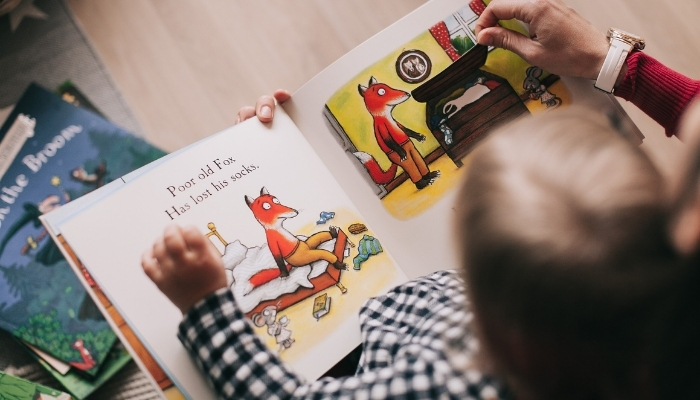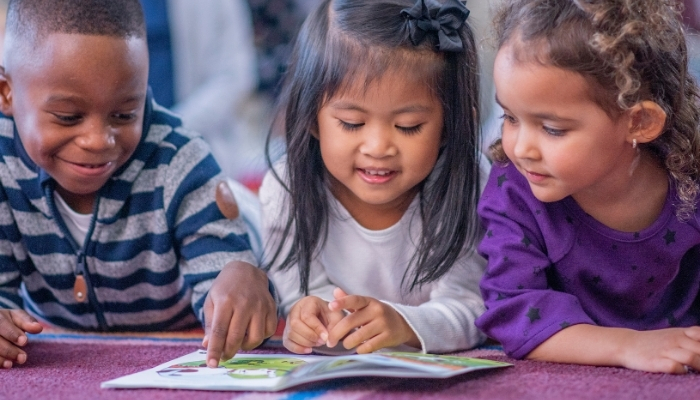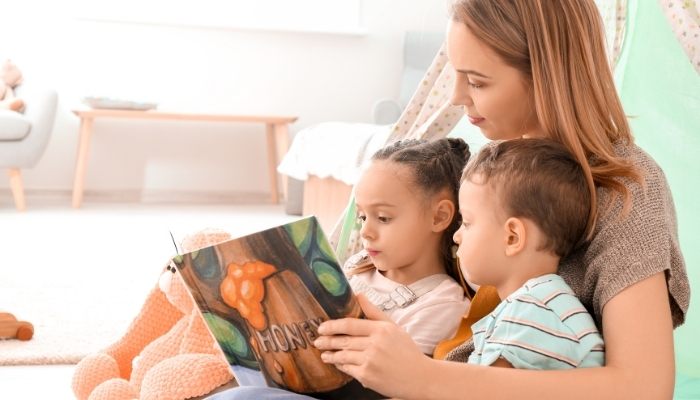In early childhood education, pre-reading skills form the foundation for future reading success. These skills bridge the gap between recognizing letters and decoding words. For kindergarteners, it’s more than knowing the ABCs; it’s about developing the mental tools to understand written language.
This blog explores key pre-reading skills like phonemic awareness and letter recognition, along with creative activities to strengthen them. Whether you’re a parent supporting early literacy at home or a teacher engaging young learners, this guide offers practical ways to build a love for reading before children start to read independently.
Quick Glance
-
Skills such as phonemic awareness and letter-sound connection lay the foundation for independent reading and future literacy success.
-
Turn letter identification into a meaningful game by linking letters to real-world objects your child already recognizes, deepening their connection to the alphabet.
-
Through fun activities like rhyming games and sound clapping, children begin to hear and manipulate sounds, which helps them decode words when they start reading.
-
Understanding how text works (from left to right, top to bottom) helps children engage with stories and build ownership over reading materials.
-
Make reading exciting by matching books to your child's interests - dinosaur books for a dino lover or space stories for a future astronaut. This sparks genuine enthusiasm for reading.
The Importance of Pre-Reading Skills

But why does it matter?
Research shows that 37% of children enter kindergarten lacking essential skills for lifelong learning, and 50% of children from low-income communities start first grade up to two years behind their peers. This shows the urgent need for early interventions and support to close these gaps.
These early steps directly affect how children approach reading as they grow. The ability to identify letters, recognize sounds, and understand print concepts gives children the tools they need to decode words, comprehend stories, and eventually become fluent readers.
The Impact of Strong Pre-Reading Skills:
When children have a solid grasp of pre-reading skills, they're not just ready to read; they're equipped to thrive in a world of words. Children who master these foundational skills early are more likely to become confident readers and strong communicators as they progress in their education. Early literacy skills don't just set children up for success in reading; they also prepare them for success in other areas of life.
For parents and teachers alike, focusing on pre-reading skills isn't just about getting kids ready for kindergarten - it's about helping them develop a lifelong love for language and reading.
Also Read: 5 Simple Steps To Teach Kids To Read
With a clear understanding of why pre-reading skills matter, let’s break down the key skills every kindergartener needs and how they serve as the building blocks of early literacy.
Key Pre-Reading Skills for Kindergarten
Before children can read fluently, they need to understand how language works at its most basic level. Pre-reading skills are the foundational building blocks of literacy, enabling individuals to think, communicate, and interact effectively with the world around them. In kindergarten, these skills start to blossom as children learn how letters, sounds, and words come together to create meaning.

Let's take a deeper look into the key pre-reading skills every child should develop in kindergarten, and how these skills can shape their academic journey.
1. Letter Recognition:
It may seem obvious, but before children can start piecing words together, they need to master the alphabet - not just recognizing that A is “A," but understanding that each letter has a sound, a shape, and a name. This skill is essential because it's the first concrete step toward reading. Letter recognition helps children decode written words by associating each letter with its corresponding sound.
However, this isn't about having kids memorize an alphabet song. It's about connecting letters to meaning. Use interactive activities such as letter treasure hunts, where kids find objects that start with certain letters, or letter puzzles that they assemble to match the shape and sound.
2. Phonemic Awareness:
Phonemic awareness is not just about hearing sounds; it's about understanding that words are made up of individual sounds. This skill lays the groundwork for children to decode words and develop the ability to read independently. Without phonemic awareness, decoding and understanding written words is like trying to put together a puzzle without the right pieces.
For example, being able to hear the beginning sound of “cat” and knowing that it’s the “c” sound is an essential step in reading. To build this, make it playful. Clap out the sounds in simple words, or try rhyming games where children figure out what word rhymes with “hat” or “dog.” Activities like these help children isolate sounds in words and give them the tools to begin reading with confidence.
3. Print Concepts:
Before children can read fluently, they need to understand how text works. Print concepts teach children that words on a page carry meaning and that sentences are read from left to right. Understanding the basic structure of print helps children engage with books in a meaningful way, instead of just seeing squiggles on a page.
But it's not enough to read books aloud; children need to interact with the text. For example, point to the words as you read, ask them to follow along with their finger, and identify the title or the author.
These interactions turn reading into a shared experience, where children not only learn how words work but also gain a sense of ownership over the process. Once they understand that books have a structure, they are more likely to pick up a book on their own, excited to explore the world of words.
4. Rhyming and Syllable Awareness:
Rhyming helps children identify patterns in words, while syllable awareness teaches them to break words into smaller parts. Together, these skills help children develop a musical ear for language that sets them up to recognize and decode longer words later on.
Engage your child with rhyming books or create your own rhymes together. You can also use clapping games to help children break words into syllables, making it a hands-on way to practice this concept.
By incorporating rhyming and syllables into daily activities, children begin to identify patterns in language, which makes reading and writing feel natural and intuitive as they grow.
Also Read: Benefits of Reading Aloud for Children
Now that we've covered the essential skills, it’s time to bring them to life! Here are creative, engaging activities that will make developing pre-reading skills both fun and effective.
Fun Activities to Develop Pre-Reading Skills

Building pre-reading skills should be authentic, interactive, and exciting for young learners. At this stage, children are still absorbing the world around them, so activities need to feel organic and immersive, integrating learning into their everyday lives. The beauty of pre-reading skills is that they can be developed naturally through play, conversation, and simple daily activities.
Let’s explore some creative and meaningful activities that can cultivate these essential skills while making learning enjoyable.
1. Letter and Sound Matching:
Letter recognition isn't just about memorizing the alphabet; it's about helping children connect letters with their corresponding meanings. Matching letters to objects that start with the same sound is a powerful way to help kids understand how language works.
-
For example, if you're learning the letter “B,” you can turn it into a game of discovery. Ask your child to find books, balls, or even bananas around the house.
-
When kids associate sounds with real-world objects, it builds a bridge between abstract letters and the concrete world around them. It's not only about recognition, but also about making those connections stick, and helping them see letters as more than symbols, but as building blocks for the words they encounter daily.
2. Sing Songs and Nursery Rhymes:
Songs and rhymes are essential for developing a child's phonemic awareness. When children listen to and repeat rhymes, they're practicing the ability to hear and manipulate sounds in words. Rhymes naturally emphasize sound patterns, which prepare kids for word recognition and decoding when they start reading.
-
Take the classic nursery rhyme “Twinkle, Twinkle, Little Star” and play with it by substituting new words. For example, ask, “What would happen if we used the word cat instead of star?”
-
This playful manipulation of sounds encourages children to think about language as something they can shape and transform. By making rhymes and songs part of your daily routine, you're embedding phonemic patterns in ways that feel like an enjoyable game, not a task.
3. Storytime with Predictive Questions:
The act of reading is more than just reading words - it’s about engaging with the story and nurturing comprehension from the get-go. Storytime is all about actively participating in the narrative.
-
Predictive questions, like “What do you think will happen next?” or “How do you think the character is feeling?” prompt children to start thinking about the storyline and characters, which strengthens their ability to follow the text.
-
Rather than just narrating the book, let your child be a part of the story. Ask them to predict outcomes or explain their thoughts about the characters' actions. This approach sparks their imagination, helping them understand that stories are more than just words.
4. Interactive Letter Hunts:
Kids love a good treasure hunt, and when that hunt involves letters, it becomes an engaging and educational adventure. Turn letter recognition into a scavenger hunt, where children have to find objects that begin with a particular letter, or even better, letters hidden around the house.
-
As you guide them through the hunt, encourage them to say the letter and associate it with a word they find. This physical engagement with letters creates a more dynamic connection to the symbols they're learning.
-
These interactive hunts help children see letters not just as abstract shapes, but as living parts of their world. Whether they're searching for “A” in their cereal box or “M” on a magazine cover, they're not just recognizing letters. They're seeing how letters show up everywhere, deepening their understanding of language.
5. Drawing and Crafting Letters:
Reading and writing are about understanding how letters come together to form words. One of the most effective ways to help children internalize letter shapes and sounds is through creative, hands-on activities.
-
Drawing letters with markers, tracing them with their fingers, or crafting letters out of playdough provides a tactile connection to the alphabet.
-
Encourage your child to draw the letters of their name or to craft their favorite animals using the shapes of letters. These activities help kids connect the physical act of creating letters with the mental understanding of what those letters represent.
Also Read: 5 Strategies to Assist Your Year 5 Child Struggling With Reading and Writing
While activities are key to building skills, cultivating a genuine love for reading is just as important. Let's explore how to nurture your child's curiosity and excitement for books, making reading feel like a natural part of their world.
Encouraging a Love for Reading Early On

At the heart of every great reader is a natural curiosity, a desire to know more, to ask questions, and to explore new worlds through words. The most effective way to encourage this curiosity in young children is by showing them that reading isn't just a school activity; it's a gateway to discovering things that interest them.
-
Introduce books and materials that tap into your child's interests and passions. If they love dinosaurs, find a few dinosaur-themed books to explore together. If they're fascinated by space, get creative with a space-themed reading adventure.
-
Don't limit reading time to only "serious" or academic books. Balance it out with picture books, interactive stories, and even comics that cater to their interests. The goal is to make reading feel like a time of joy and shared experience, where they feel safe to ask questions and make up their own stories.
-
Incorporate reading into daily tasks, like reading the grocery list, road signs, or even recipe instructions while cooking. By showing how reading is an integral part of life, you help children connect reading to their world beyond the pages of a book.
Over time, these small, consistent moments of reading will build confidence, while making reading second nature to them.
Conclusion
Pre-reading skills are essential for setting your child up for success in reading and beyond. By focusing on skills such as letter recognition, phonemic awareness, and print concepts, you're providing them with the foundation they need to become confident readers.
If your child needs extra support in these areas, Funfox offers personalized small-group tutoring to strengthen these skills. Our interactive Readers Clubs help build confidence while making reading a fun experience.
Ready to help your child get started? Contact us today to book a complimentary trial class and provide your child with the support they need to develop strong pre-reading skills.
FAQs
1. How can I help my child connect letters to real-world objects in a meaningful way?
You can turn everyday activities into letter-recognition games by connecting letters with real-world objects. For example, while cooking, ask your child to identify the first letter of ingredients, such as "B" for banana or "C" for carrot. These real-life connections reinforce learning and make it an enjoyable experience.
2. What is the best way to develop phonemic awareness in young children without overwhelming them?
Start with simple rhyming games and clapping out syllables. Keep it playful—sing songs, read rhyming books, and encourage your child to guess rhyming words. Gradually, these activities will help your child tune into sounds without feeling like it’s a task.
3. How can I encourage my child to be more engaged during storytime?
Make storytime interactive by asking predictive questions, like, “What do you think will happen next?” or, “Why do you think the character made that choice?” You can also pause to discuss the pictures, turning the story into a shared, engaging experience that boosts comprehension.
4. Are there any specific activities to strengthen a child’s understanding of print concepts?
Absolutely! Try activities like tracking words with a finger as you read together, or ask your child to point out the title, author, and where the story begins. By reinforcing print directionality and basic book structure, these activities set the stage for independent reading.
5. How do I introduce reading and writing skills in a way that feels natural and not forced?
Start by incorporating letter recognition and sound exploration into daily routines, like identifying letters on street signs or food labels. By naturally blending reading and writing into their environment, it becomes an integral part of the fun, rather than an academic obligation.















